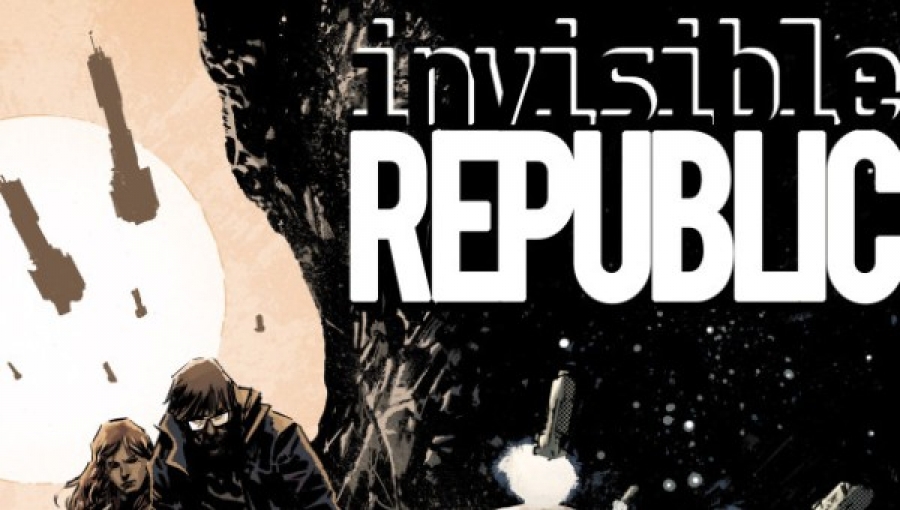Some of the best stories start small, focusing on a microcosm of the world you’re about to enter. You’re zoomed in on a couple of key characters, one event, however small, before slowly pulling back to reveal the magnitude of events that transpire from that singular moment. Star Wars, Avatar: The Last Airbender, and Lord of the Rings all have humble beginnings and absolutely epic endings that affect the entire world (or galaxy) in which they live. While I don’t know yet if writer and artist Gabriel Hardman (Deep Gravity, Savage Hulk) and writer Corinna Bechko’s (Deep Gravity, Savage Hulk) series, Invisible Republic, will live up to the aforementioned titles, it makes a lot of the same bold promises right up front, and that entices and really does excite me.
And yes, there is a surfeit of science fiction hitting the newsstands these days. (I also reviewed Kaptara #1 today.) It can be overwhelming – a lot coming from Image Comics. I will never complain about this. But, it can be hard to know what to grab when you’re on a budget. There’s the epic, sci-fi/fantasy space opera antics of Saga, the new sheriff in a very Wild West feeling of Copperhead, the poetical genre and format-exploding Ody-C (one of my favorites!), the allegorical, female empowerment-laced Bitch Planet, the reality-hopping, chaos-ensuing Black Science, and so on. Thankfully, most all of it is really good. Invisible Republic falls into the more thoughtful, real-world political thriller category. At least one gets that from the microcosm that we’re zoomed in on.
So, let’s talk about the micro. On a distant moon, after the death of a dictator (Arthur McBride), a down-on-his-luck writer and journalist (Croger Babb) discovers the pages of a journal written by McBride’s cousin, Maia Reveron, promising an unseen look at the man McBride actually was before he became a dictator. The ensuing events play out split between the present and the past, working in tandem, undoing the myths from realities surrounding McBride. In the past, McBride and Reveron have escaped the farm in which they were essentially slaves. Upon running into three soldiers, McBride unleashes his violent side, killing them, then feeding the bodies to the carnivorous fish in the nearby waters, and in both instances showing his cousin he’s not even close to the man she thought he was. That was issue one. In issue two, we pull back ever so slightly as they enter the city, looking for transport to another world. She is beginning to distrust him; you aren’t quite sure what he’s going to do from moment to moment – will he get them in hotter water or is he simply street smart enough to know what must be done and when it must be done in order to survive. Street smarts, it turns out, are something Maia lacks completely. Meanwhile, in the present tense, someone is trying to stop Babb from continuing his research and writing about who McBride actually was.
The story, thus far, is good, but one doesn’t stop watching Star Wars when Luke is knocked unconscious by the sand people. You keep watching it, because of the promise that is given that there’s something greater to be discovered, beyond the scope of what Luke knows and has experienced.
Hardman and Bechko have made another promise by even approaching a science fiction story involving political figures, at least if they have aspirations that this will be a great story. They have the opportunity to do what science fiction does best, tell us about ourselves and the world we live in through the story they are telling and characters they have created. It’s true it could be a very enjoyable book even without that, and it is, but the portent of things to come, things that they are paving their way toward will keep me reading in earnest for the moment.
On a purely artistic level, the writing is good. Hardman and Bechko take their time, easing the character dynamics along, building the intensity slowly. Structurally, where they choose to jump back and forth in time can sometimes lesson the effectiveness of certain cliffhangers, which, in the end, is small beans, but something I did notice. The art by Hardman is more than solid, very filmic. The afterward Bechko writes about the probability and difficulty of space travel and colonization really feeds into the visual world Hardman is creating. You sense the chaos and urgency in a lot of the imagery. The color pallets used by Jordan Boyd, washing out entire sections as if through different filters, not only gives us the immediate sense of shifting time periods, but also creates an otherworldly feel in which the sun’s moon may not be hitting the same way our sun hits Earth, maybe a different atmosphere or different colored star – who knows, but it’s effective.
I hope this book continues to play out as intelligently as it has so far, staying grounded in the reality it’s created. Never becoming laser tag, never introducing alien races – all that can be extremely fun, but we need our vitamins along with our sugar.

